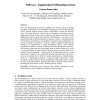2015 search results - page 61 / 403 » Hidden Software Capabilities |
WS
2010
ACM
13 years 7 months ago
2010
ACM
One of the most important decisions researchers face when analyzing software systems is the choice of a proper data analysis/exchange format. In this paper, we present EvoOnt, a s...
TOSEM
2002
13 years 8 months ago
2002
Abstract. The Unified Modeling Language (UML) is a family of design notations that is rapidly becoming a de facto standard software design language. UML provides a variety of usefu...
CLEIEJ
2007
13 years 9 months ago
2007
The term “Self-healing” denotes the capability of a software system in dealing with bugs. Fault tolerance for dependable computing is to provide the specified service through ...
ISBI
2002
IEEE
14 years 9 months ago
2002
IEEE
In this paper we summarize our results for two classes of hierarchical multi-scale models that exploit contextual information for detection of structure in mammographic imagery. T...
EDBT
2008
ACM
14 years 9 months ago
2008
ACM
K-anonymisation is an approach to protecting privacy contained within a dataset. A good k-anonymisation algorithm should anonymise a dataset in such a way that private information...

